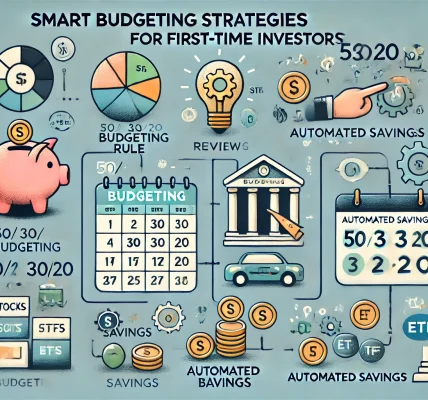📚 Introduction:
Budgeting can feel overwhelming, especially when you’re juggling multiple expenses, savings goals, and investment plans. But what if you could put your budget on autopilot and let technology do the hard work for you? Automating your budget not only saves time but also reduces the risk of missing payments or neglecting your savings.
In this guide, we’ll explore how to automate your budget effectively, allocate funds to the right categories, and ensure that you stay financially disciplined without constant effort. Whether you’re a beginner or a seasoned investor, this strategy can help you build wealth and secure your financial future.
🎯 Why Automate Your Budget?
Automating your budget helps you:
- Save Time and Effort: No need for manual expense tracking or constant monitoring.
- Avoid Missed Payments: Automatic bill payments prevent late fees and penalties.
- Ensure Consistent Savings: Regular contributions to savings accounts build wealth over time.
- Minimize Emotional Spending: Automation reduces impulse purchases by directing funds to predetermined goals.
📊 Step-by-Step Guide to Automating Your Budget
📝 Step 1: Analyze Your Current Financial Situation
Before automating your budget, you need to assess your income, expenses, and financial goals.
✅ Key Actions:
- Review your bank statements to identify fixed and variable expenses.
- Categorize your spending into essentials, discretionary expenses, and savings.
- Identify any high-interest debt that should be prioritized.
Pro Tip:
Use budgeting apps like YNAB, Mint, or PocketGuard to get a clear overview of your spending patterns.
📝 Step 2: Set Clear Financial Goals
Define your short-term and long-term goals. These could include:
- Building an emergency fund.
- Paying off high-interest debt.
- Investing for retirement or future goals.
How to Do It:
- Establish a timeline for each goal.
- Assign a specific percentage or amount of your income toward achieving these goals.
📝 Step 3: Choose the Right Bank Accounts
To automate your budget effectively, you’ll need multiple accounts:
- Primary Checking Account: For salary deposits and paying bills.
- Savings Account: For emergency funds and future goals.
- Investment Account: For long-term wealth building.
✅ Pro Tip:
Use high-yield savings accounts (HYSAs) to maximize your returns on idle cash.
📝 Step 4: Automate Your Income Allocation
Set up automatic transfers to ensure your income is distributed according to your budget.
✅ Suggested Allocation:
- 50% for Essentials: Rent, utilities, groceries, insurance.
- 30% for Wants: Entertainment, dining, shopping.
- 20% for Savings and Debt Repayment: Emergency funds, retirement, investments.
How to Automate:
- Use your bank’s online platform to schedule automatic transfers after each paycheck.
- Direct a percentage of your income to savings and investment accounts automatically.
📝 Step 5: Automate Bill Payments
Avoid the risk of late payments by setting up automatic payments for your fixed expenses.
✅ Key Bills to Automate:
- Rent or mortgage payments.
- Utility bills (electricity, water, internet).
- Insurance premiums.
- Minimum payments on credit cards and loans.
How to Set It Up:
- Enable Auto Pay through your bank or biller’s website.
- Schedule payments at least 2-3 days before the due date to avoid processing delays.
📝 Step 6: Automate Savings and Investments
Ensure that saving and investing become non-negotiable by automating these processes.
✅ For Emergency Funds:
- Set up automatic transfers to a dedicated savings account.
- Aim to save 3-6 months’ worth of essential expenses.
✅ For Retirement:
- Automate contributions to EPF, PPF, or NPS if you’re in India.
- For international users, automate contributions to 401(k) or IRAs.
✅ For Investments:
- Set up SIP (Systematic Investment Plan) for mutual funds.
- Automate recurring contributions to stock portfolios or ETFs.
📝 Step 7: Use Budgeting and Automation Tools
Leverage technology to track, analyze, and adjust your automated budget.
✅ Top Tools to Consider:
- YNAB (You Need a Budget): Helps you allocate every rupee and adjust dynamically.
- Mint: Provides real-time financial insights and spending alerts.
- PocketGuard: Prevents overspending by showing how much money is “safe to spend.”
Pro Tip:
Set notifications to get regular updates on your account balances and spending patterns.
💡 Pro Tips to Maximize Automated Budgeting
🎯 1. Pay Yourself First
Automate your savings and investments before spending on discretionary items.
- Set up automatic transfers to your savings or investment accounts right after payday.
🎯 2. Build a Buffer for Unexpected Expenses
Create a buffer fund for unexpected expenses to avoid dipping into your emergency fund.
- Allocate a portion of your budget to this account and automate transfers.
🎯 3. Review and Adjust Periodically
Even though your budget is automated, review it every 3-6 months.
- Identify any changes in expenses or income that require adjustments.
🎯 4. Increase Savings Incrementally
Set your savings contributions to increase automatically as your income grows.
- Aim to increase by 1-2% annually.
🚨 Common Mistakes to Avoid in Automated Budgeting
- Setting It and Forgetting It – Regularly review your budget to ensure it aligns with your goals.
- Ignoring Small Expenses – Track small recurring payments that can add up over time.
- Failing to Update Automation After Pay Raises – Adjust contributions to reflect increased income.
📈 How to Track Progress After Automating Your Budget
Even after automating your budget, tracking progress is essential to stay on course.
✅ Key Metrics to Monitor:
- Monthly savings and investment contributions.
- Total net worth growth.
- Spending trends in essential and discretionary categories.
Pro Tip:
Set quarterly reminders to assess your financial health and make adjustments if necessary.
🎉 Conclusion: Take Control of Your Finances Through Automation
Automating your budget is one of the most effective ways to stay financially disciplined, build wealth, and achieve long-term financial security. By setting up automatic transfers, paying your bills on time, and consistently contributing to savings and investments, you can eliminate the stress of manual budgeting and focus on growing your wealth.
With the right strategy and tools, automating your budget can help you save more effortlessly and create a strong foundation for financial success.



